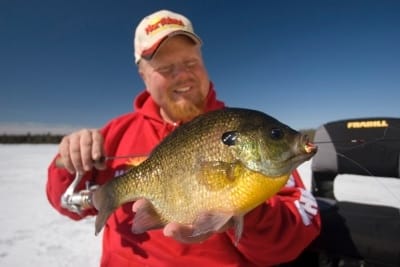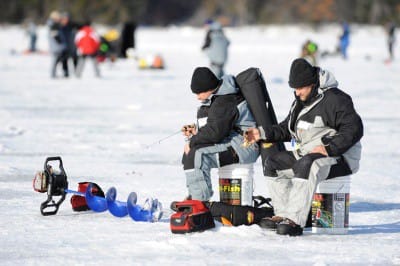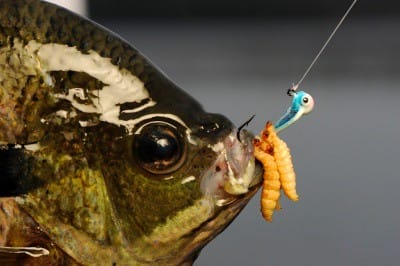Submitted By:
Edited by USA Author M.D. Johnson
 Everywhere ice forms and people fish from atop, two factors – reluctant cold-water critters, and the necessity that is quality electronics – play major roles. And so it was during the 2009 North American Ice Fishing Championship (NAIFC).
Everywhere ice forms and people fish from atop, two factors – reluctant cold-water critters, and the necessity that is quality electronics – play major roles. And so it was during the 2009 North American Ice Fishing Championship (NAIFC).
From all across the United States, 84 of the country’s finest ice angling teams converged on Boom Lake in Wisconsin to test their skills against both finicky fish and extreme fishing pressure. At stake were $25,000 cash and the bragging rights to the title of Ice Fishing Champions.
Over the course of the 2009 NAIFC tournament season, teams had fished seven regional events; these events in turn ultimately determined qualifiers for the big show. Returning for another run at the title were notable teams including previous champions. As it turned out, they would play a prominent role in the final standings.
Boom Lake is a 2,200-acre flowage on the Wisconsin River with a maximum depth of just over 30 feet. Although the lake’s topography contains vast areas of uniform depth, anglers often target weedy flats, rock edges, and manmade structure like cribs and pallet piles when hunting bluegills and black crappie, the primary target species of NAIFC anglers. On each of the two tournament fishing days – December 19 and 20- teams were allowed to weigh up to eight crappie and eight sunfish. For most, this proved a daunting task, as no tean weighed 16 fish on consecutive tournament days.
On day one, it was literally a foot race to one or two key fishing areas on Boom. The first teams out of the shoot set up and began drilling in patterns that would allow for limited mobility among the competition. At the weigh-in, Michigan veterans Mike Boedeker and Dave Young arrived with 13 fish weighing a total of 4.94-pounds, including a 1.15-pound crappie. This tally was enough for Boedeker and Young to hold a slim lead over Jacek Gawlinski and “Zibi” Wojcik, who put together one of only two day one limits. In the mix were the illustrious “Ice Trollers”- Joe Pikulski and Myron Gilbert – who had won the event in 2008. Landing the only other limit of the day was Frabill-sponsored Team Prowler – Tony Boshold and Bob Horn – who brought to the scorer’s table a 4.5-pound bucket of panfish, netting them fourth place.
While the majority of the teams set up shop in the community hole, coaxing every bite, there were a few such as Pikulski and Gilbert who drilled loads of holes in search of roaming fish. Key areas included subtle outer rims of depressions in the basin, most of them dropping no more than a few feet below the surrounding terrain. Another active team was newcomers Roy Mutter and Myron Gilbert Jr. This duo targeted crappie on 26- to 30-foot edges in the middle of the lake, finishing day one with eight slabs and a Top 10 spot.

Nearly one-third of the teams drew a blank on day one. In addition to the ultra-finicky panfish bit, teams were all fishing within earshot and transducer signals from competing flashers rendered many units unreadable. Several anglers noted that they were able to minimize on-screen interference by dropping their transducer as deep as possible, or beneath the “noise.” Most, however, quickly realized that certain flasher units were better at dealing with the interference.
“It was pretty obvious the power of theMarCum units was taking most of the other flashers out of the game,” noted Joe Pikulski. “Guys just couldn’t tune out all the clutter on their screen, and couldn’t read their jig or the fish. It was combat fishing.”
Fortunately for anglers such as Pikulski, as well as the teams of Young-Boedeker and Boshold-Horn, their MarCum LX-5s tuned out the interference.
“This event was a real eye-opener for some of the teams, as far as electronics go,” said Boshold. “We all saw that the guys using MarCums had an advantage.”
Other anglers took advantage of these close-quarter conditions by using a specially designed Hexi-Fly fromNorthland Tackle. Touted as a flasher-friendly ice jig, the Hexi-Fly is shaped so as to gather and return the strongest sonar signal possible. This allows anglers to dial down their flasher’s GAIN setting, thus reducing on-screen clutter while still showing strong returns from both the jig and the fish.
Back in the tightly-gathered circle of competitors, the Young-Boedeker Team had its hands full.
“We fished the 24- to 28-foot edges of two humps we found last year,” said Young. “Even with all the other anglers around, Mike and I were still able to tune out interference on our MarCums and continue reading our jigs. That was a huge factor.”

While crowding became troublesome for most, Young used his finely-honed tightlining skills to his advantage. “The key for me was to fish a little spoon-type jig that represents a perch eye,” said the pro. “It’s basically an Eye-Dropper Jig – a small Colorado blade with a big eyeball painted on it. I lightly hooked on a single wax worm and gave it a squeeze to get the good juices to ooze out. I fished this 2 to 6 inches off the bottom for the bluegills. They were really spooky. On day two, I had just one bite, but I made it count. Mike got eight. That’s why it’s nice to have a partner who can fish.”
Though their second-day efforts proved noble, their final weight fell just five one-thousandths of an ounce short of the title. For the second straight year, Young and Boedeker settled for a second-place finish.
Conversely, Team Pikulski-Gilbert took a more active approach.
“We started in a deep spot we found the year before and caught eleven crappie and a few bluegills,” said Pikulski. “Later, we kind of got pushed off and started ‘trolling.’ Luckily, on day two, we pulled five fish off our first spot.”
The Ice Trollers notched a respectable third-place finish, with 6.75 pounds total.
Likewise, Roy Mutter and Myron Gilbert Jr. were drilling holes as if their lives depended on it.
“One guy would drill, while the other would check the flasher for crappies,” said Mutter. “When we’d mark fish, we’d drop our jigs to just above the level of the crappies. We’d just keep pounding the jig to get the fish to chase.”
Their enthusiastic efforts on day two paid off with 10 fish, 7.27 pounds, and the coveted 2009 NAIFC title.
As the event concluded, two very key points became crystal clear. One, tough conditions require superior concentration be placed – and maintained – on lure selection and presentation in order to capitalize on each and every strike. And second, the ability of electronics to perform under extreme and often competitively adverse conditions is paramount to success. They’re variables likely to appear, once more, as these and other elite ice anglers gather Up North for the 2010 Challenge.



